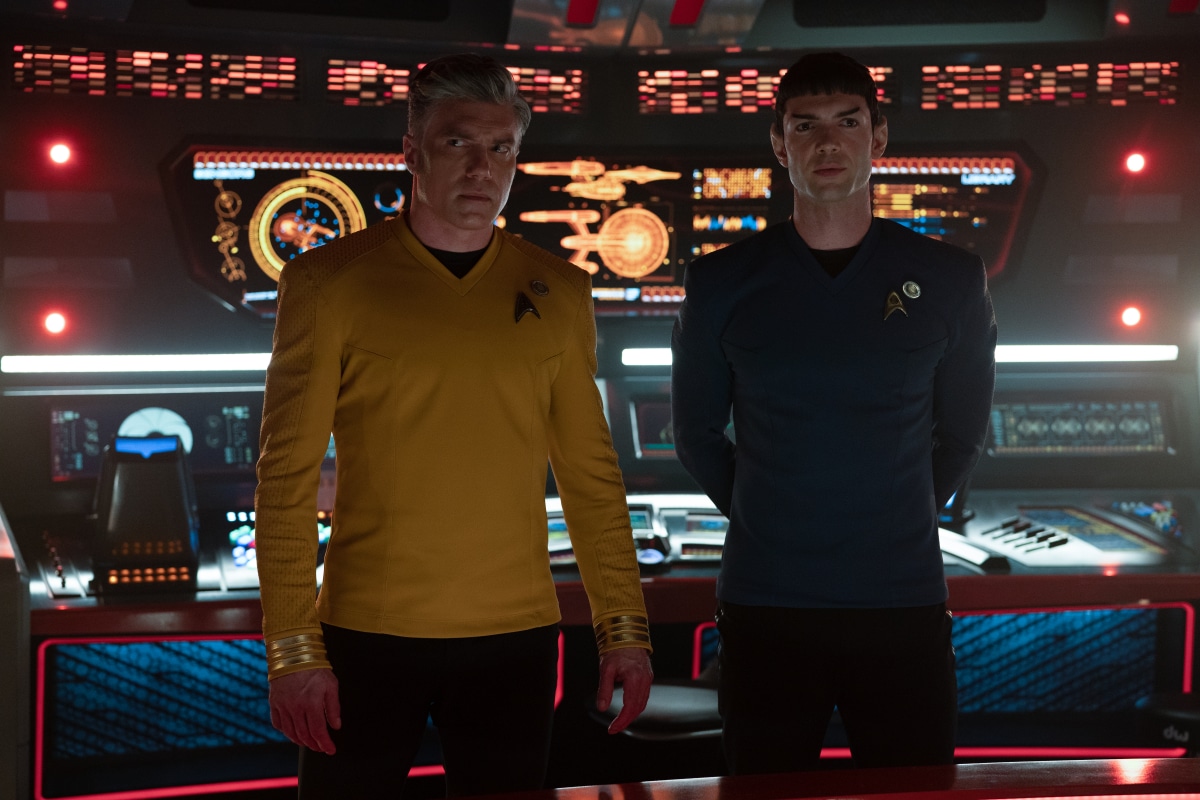This discussion and review contains spoilers for Star Trek: Strange New Worlds episode 4, “Memento Mori.”
For the fourth consecutive week, “Memento Mori” finds Strange New Worlds revisiting Familiar Old Plots.
In “Memento Mori,” the Enterprise is ambushed by the Gorn. The ship is badly damaged. The crew is separated into smaller groups. The cast is embroiled in a high-stakes battle for survival against an opponent that has no interest in negotiation or reason. The episode serves as a hybrid between an old submarine thriller and a disaster movie. Like “Strange New Worlds,” “Children of the Comet,” and “Ghosts of Illyria” before it, this is well-trodden ground for the franchise.
“Balance of Terror” is perhaps the best example of Star Trek telling this kind of story, as Captain Kirk (William Shatner) finds himself matched in a battle of wits against an anonymous Romulan commander (Mark Lenard). It is one of the best episodes of Star Trek ever produced, even more than half a century after it was originally broadcast. It also serves as something of a cautionary tale. While the franchise has repeatedly tried to replicate that success story, it has very rarely been equaled.
To be fair, “Memento Mori” is a bit closer to later variations on the storytelling model, most obviously “Disaster” on The Next Generation, and “Civil Defense” or “Starship Down” on Deep Space Nine. In these stories, an enemy attack or freak accident triggers a crisis that splits up the primary cast across several plot threads that unfold concurrently until the crisis is eventually resolved. The result is an episode that feels less like a single story than several shorter interlocking stories.

“Memento Mori” splits up its cast into several smaller sets. Pike (Anson Mount) deals with the enemy vessel on the bridge, while Noonien-Singh (Christina Chong) works through her own trauma involving the Gorn. Uhura (Celia Rose Gooding) and Hemmer (Bruce Horak) are trapped together in Engineering. Number One (Rebecca Romijn) is injured and sent to Sickbay, where she is in the care of M’Benga (Babs Olusanmokun) and Chapel (Jess Bush).
Even these individual plot threads feel highly derivative of plot threads from similar episodes. In particular, the pairing of Hemmer and Uhura recalls the similar pairing of Geordi (LeVar Burton) and Crusher (Gates McFadden) in the cargo bay in “Disaster” and Bashir (Alexander Siddig) and Dax (Terry Farrell) in “Starship Down.” In all three cases, the premise is that the disaster throws together two characters in the ensemble who have little reason to interact with one another.
As with both “Children of the Comet” and “Ghosts of Illyria,” there are several clear reasons why Strange New Worlds would choose to tell a story like this so early in its first season. Most obviously, like the infection storyline in “Ghosts of Illyria,” the structure of “Memento Mori” allows the production team to make the most of the core ensemble. It gives a significant portion of the cast a lot to do, which is important for a show still figuring out the rhythms of its own internal ensemble.
Historically, these sorts of stories also functioned as “bottle episodes.” The term “bottle episode” has been woefully misused in modern television discourse, drifting away from its original intended usage. These days, the term is applied to any standalone episode of television, treating it as a description of the narrative mechanics of a given episode. In reality, the term “bottle episode” is rooted in more mundane production realities: a desire to balance the budget.

Traditionally, a bottle episode is a cost-effective production that uses the primary cast and the standing sets of a given show in order to minimize costs that would be incurred by doing extensive location shooting, building new sets, or by featuring an expansive supporting cast. There are plenty of great examples of bottle episodes within the Star Trek canon, from “The Tholian Web” to “Remember Me” to “Shuttlepod One.”
“Memento Mori” does do some location shooting, with the brief away team mission down to the planet surface in the opening sequence. However, that excursion is abridged and the scenes are shot at night in order to avoid having to build large-scale props or employ extensive computer-generated imagery. Similarly, there are some guest characters, such as the survivors of the original Gorn attack, but they are largely featured in that same opening sequence.
“Memento Mori” appears to be a cost-effective episode of Strange New Worlds. This is particularly obvious considering the sets and location shooting in “Strange New Worlds,” not to mention the new sets and assets that had to be created for the away team subplots in both “Children of the Comet” and “Ghosts of Illyria.” Strange New Worlds looks like an expensive television show, and it makes sense to have a (relatively) cost-saving episode in the middle of the season.
That said, it does feel like “Memento Mori” might have worked better later in the season, after the audience had a chance to properly get to know the ensemble. While Strange New Worlds has clearly reverted to Michael Piller’s model for writing The Next Generation, the show has only really focused on two members of the ensemble individually: Pike in “Strange New Worlds” and Uhura in “Children of the Comet.” Number One drove “Ghosts of Illyria,” but it was more an ensemble piece.

It doesn’t help matters that Uhura’s plot thread in “Memento Mori” is largely a retread of her arc in “Children of the Comet.” Once again, Uhura is an inexperienced young officer thrown into a situation where she seems to lack the experience to survive, but who — despite her discomfort — promptly proves herself an invaluable member of the crew. It doesn’t feel like “Memento Mori” tells the audience anything more about Uhura than “Children of the Comet” already did.
This is a larger problem with “Memento Mori.” Submarine thrillers are great fun. They are high-stakes adventures in claustrophobic environments that place characters under tremendous pressure both literally and metaphorically. However, Pike’s showdown with the Gorn really doesn’t seem to offer anything different than Kirk’s battle of wits against the Romulan commander in “Balance of Terror,” and none of the characters pop as well as those in “Civil Defense” or “Starship Down.”
There’s an unearned attempt at gravitas here. The story is framed around “Starfleet Remembrance Day,” which is another holiday to add to the in-universe calendar alongside “First Contact Day” and “Captain Picard Day.” There might be an interesting angle to explore around that hook, with the long-lingering question of whether Starfleet is a military organization. It might also be interesting to explore or interrogate the obsession with symbols of patriotic mourning in places like Great Britain.
This problem is compounded by the story’s treatment of the Gorn as one-dimensional monsters. “They aren’t supernatural,” Noonien-Singh explains. “But they are monsters. The Federation teaches that if we can find a way to empathize with an enemy, then they can one day become our friend. They’re wrong. Some things in this universe are just evil.” This is a rather bold statement for a Star Trek episode, given the franchise’s tendency to humanize the Federation’s adversaries.

The Klingons went from being Yellow Peril Cold War stand-ins to becoming staunch allies of the Federation. The franchise added depth and complexity to alien races like the Romulans, the Cardassians, and even the Borg in episodes like “Face of the Enemy,” “The Wounded,” and “I, Borg.” One of the most striking things about “Balance of Terror,” an episode that is a huge influence on “Memento Mori,” is that the anonymous Romulan commander becomes a truly tragic figure.
“Memento Mori” might be setting up some later story arc in which Noonien-Singh learns that the Gorn are not literal monsters. The underrated third season of Enterprise was built around the crew coming to a similar realization about the Xindi. Even “Arena” ends with Kirk refusing to kill his Gorn opponent. However, the show’s episodic structure insists that “Memento Mori” be judged on its own merits, and the result is an episode that feels strangely and frustratingly reactionary.
“Memento Mori” is not so much a reminder that one must die as a reminder that so many of these Star Trek: Strange New Worlds stories have been told better elsewhere and before.






Published: May 26, 2022 11:00 am